The Russian Blue originated from Russia. This cat breed is also known as the Archangel Blue. It is thought that during the 1860’s, sailors travelled with the Russian Blue from the Archangel Isles to the U.K and Northern Europe.

Females: 21

Female: 7-10


Physical Description
The Russian Blue has short hair that is plush. The eyes are a blue-gray or emerald-green. The coat is double-layered and has both short, thick fur, and a blue-grey coat with silver tips. The Russian Blue is born with a blue coat. The coat has guard hairs that are silver-tipped. Shedding is low. This cat breed has a muscular medium-sized body. With a head that is wedge-shaped, and a flat skull, the Russian Blue has large ears that are widely spaced. The tips are pointed. The neck is long and slender. The legs are long and fine, the paws, small and rounded. The tail is long. The temperament is gentle and sweet. This cat breed is known to be sensitive to human emotions, and bonds very closely with pet parents. The Russian Blue kitten has yellow eyes as a kitten, that turn green during adulthood.
Brief History
The first Russian Blue was shown at the Crystal Palace in the U.K, and was named the Archangel Cat. This breed was refined and bred in the U.K and Scandinavia until after WW2. After the WW2, there was a lack of Russian Blue cats, and crossbreeding commenced. U.S breeders bred the Russian Blue together with the Siamese. The post-war refined the Russian Blue that was bred after the war. This is the breed standard seen today in the U.S, which is a combination of the Scandinavian and U.K Russian Blue.
Temperament
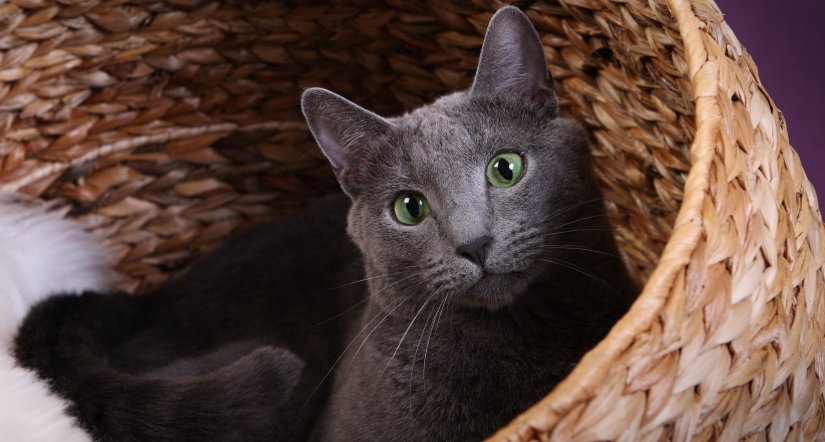
The Russian Blue is gentle and curious. This cat breed enjoys playing with his family, and loves to race around the house and climb furniture. It is a graceful and sleek cat that is emotionally in- touch with his human family. These cats are extremely sensitive, and do well with gentle children and family. Interactive cat toys and a game of Fetch will always keep the Russian Blue happy. The Russian Blue is a quiet cat breed that is usually reserved around strangers. This cat breed does well with positive clicker training. That said, this cat breed loves an active family, and does well living indoors or outdoors, as long as he is well taken of.
Special Needs
The Russian Blue does best as an indoor or outdoor cat. Many have done well out in farms as well. The Russian Blue may be prone to certain illnesses, so it’s best to always keep a close eye on this fabulous cat breed. This cat breed is intelligent, and does well with apartment living or home living. The Russian Blue needs to be indoors during the hot summer months. It is a wonderfully easy cat breed to live with, but does need mental stimulation. The Russian Blue needs lots of exercise and mental stimulation.
Litter boxes for cats need to be kept clean, or your cat may not use it. Self-cleaning litter boxes ae popular today, and help with time management, allowing for more time to play time with kitty! Opt for environmentally friendly cat litter. Litter mats help keep everything tidy.
Cats will need parasite control and routine health care throughout its life. This means vaccinating your Russian Blue. This is an important part of keeping your cats healthy throughout their lives. Consult with your veterinarian for advice as to the safest flea and tick products to use.
Your cat will also need to be spayed or neutered. Your Russian Blue needs to be protected from household dangers like cleaning supplies, toxic plants, electrical cords, and aggressive animals. Cats are carnivores, and will need a high-quality diet with plenty of fresh water every day. Exercise can be achieved through a variety of play toys that encourage running and a game of chase. Sedentary cats may be prone to obesity, and health problems later on in life. This cat breed has a huge appetite, and needs to be kept on a high-quality diet at all times. Dental hygiene is also important for this cat breed to prevent gum disease.
Possible Health Concerns
The Russian Blue is a very healthy and moderately active cat breed that may be susceptible to the following health conditions:
- Calcium Oxalate Bladder Stones: Small amounts of calcium oxalate is always present in a cat’s urine. When presented in high amounts, this will pose a problem. Oxalate bladder stones will generally affect one out of two cats in the same household, though both will be eating the same feed. Genetic predisposition may partially contribute to cats being prone to getting bladder stones, although diet and environmental conditions have been considered important contributing factors as well. Consult with your veterinarian for advice.
- Ringworm: This is an infection of the skin, hair, or claws, and is caused by a fungus called dermatophyte. This occurs in 98% of cats. It spreads easily from cats to people. Symptoms include circular, bald patches that scale and have broken hairs in a ring-like fashion. Consult with your veterinarian for advice.
- Skin Disorders: The Russian Blue may be prone to skin disorders. This cat breed is prone to idiopathic seborrhea. This is an inherited skin disorder resulting in the overproduction of an oily substance. This clumps in the cat’s fur, and causes it to smell bad. Symptoms include red and irritated skin with excessive scratching. Consult your veterinarian for advice.
Exercise
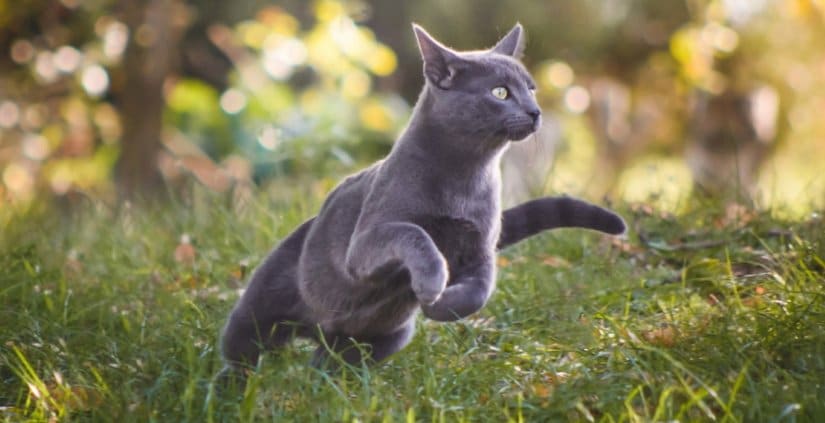
The Russian Blue cat breed needs daily exercise combined with plenty of mental stimulation through active play and interaction with people. Cat parents can use cat toys like the Mousr or Cat Dancer to get their cats to play. This will encourage your cat to play. Finding a variety of mentally stimulating cat toys will allow for your cat to lead a well-balanced life, with the right amount of exercise and mental stimulation. Cat harnesses also allow for daily walks.
The Russian Blue is well-behaved. This cat breed does best with routine and attention. Cat gyms, cat scratchers, and interactive cat toys within a cat friendly home environment work best for this fabulous cat breed. That said, this cat breed is a laid back, and very-easy-to get on with.
Look out for the latest cat toys like Ripple rug play mats, the Feather Whirls, pet cube toys, food trees, turbo scratcher toys, cat companion interactive toys, and electronic motion toys. All these and many more will keep your Russian Blue kitty entertained when you’re out and about.
Poly Rattan weaved cat scratchers make for longer lasting cat scratching posts. They are more durable, and built to last. Hemp toys for cats are irresistible. Some come with colorful feathers and hemp cord allowing for longer playtime with your feline.
Chasing, hunting, and attacking toys are some of the methods that cats will use when playing with interactive toys. When out shopping for cat toys, opt for safe TPA materials that have no toxic BPA or BHT. Multilevel spinning ball cat toys help cats bat and chase play. Ultimately, what feline pet parents need to achieve is bonding through free play and exercise.
Nutrition
The Russian Blue cat breed will need a high-quality diet. That said, a high-quality diet that is appropriate for the specific life stage of the cat is necessary. Protein as an ingredient, needs to come first. Dry cat food is a popular choice because it promotes healthier gums and teeth. Yet wet food is more often recommended by veterinarians because it provides more moisture to cats.
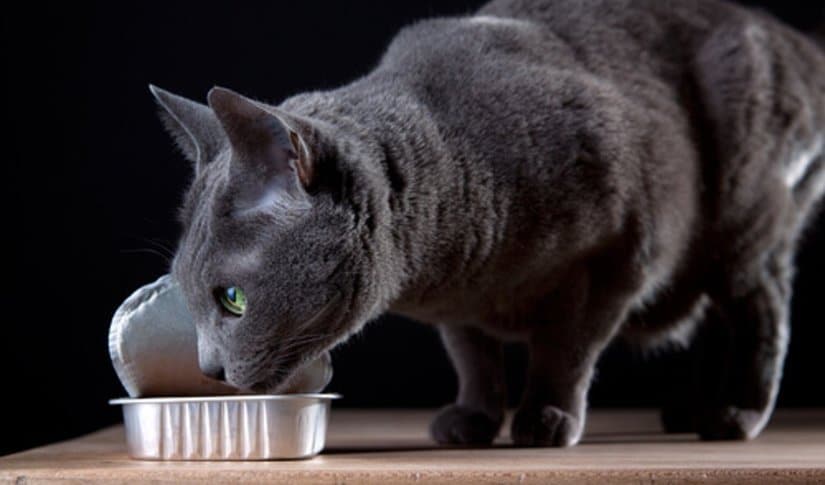
Cats don’t drink a lot of water and tend to sometimes get dehydrated. Wet cat food also has its benefits. By choosing a well-known name- brand cat food that has scientific backing, as well as quality control, cat parents can be assured that they are providing a well-balanced diet.
All cat breeds need high- quality fat and protein in their diets. They also need amino acids, including taurine that cannot be found in either human food or dog food. There are also numerous specialty diets for your cat that are formulated specifically for certain medical problems like urinary tract disorder, obesity, or kidney disease.
All cats do well by being fed twice daily. During kittenhood, kittens will need to be fed every few hours. Growing kittens need more calories, nutrients, vitamins, protein, and calories. Your cat should be able to enjoy a peaceful meal in a quiet corner of the house. Some cat parents prefer to leave cat kibble out 24/7. When looking for a high-quality cat food, here’s what to look out for:
- No low-quality fillers
- No artificial additives
- Low grade ingredients or toxic ingredients
- All cat food has to be meat-based because all cats are carnivores
- No garlic
- Plant-based ingredients should be listed after the protein-based ingredients
Consult with your veterinarian for the best dietary advice for your cat!
Grooming
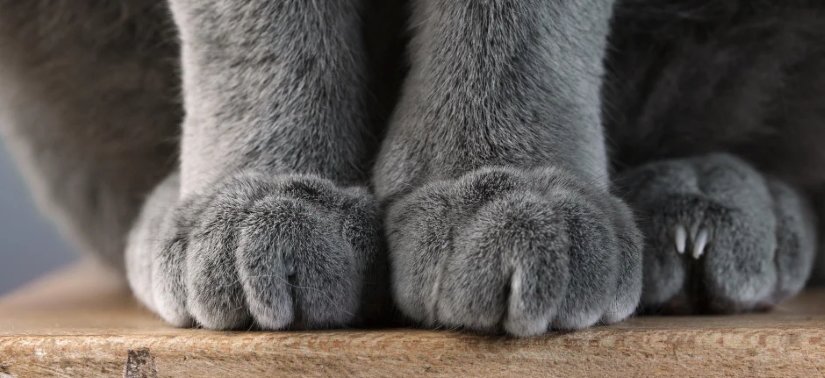
Cat pampering is a norm today with feline pet parents wanting the very best for the cats. Your Russian Blue may be susceptible to skin diseases originating from flea bites, mites, yeast infections, and infections. Opt for natural cat grooming products to help resolve these skin irritants.
All cat breeds have highly sensitive skin. By using grooming wipes and waterless shampoos in between bathing schedules, you’ll have a healthier cat.
The Russian Blue needs daily grooming to remove shedding or dead hair. Because this breed has a short and fine, soft coat, grooming is easy. Stainless steel combs help to remove dead hair. Care must be taken when grooming leg hair and body hair to avoid sensitive areas. Some cats have very sensitive areas along their backs, legs, and belly area. Curry brushes help with grooming, and will remove dead hair and debris from your cat’s coat.
Look for high-quality pet products to decrease shedding, and help prevent hairballs. Products like the Furminator will easily groom through your cat’s coat, and safely remove dead hair without hurting your cat. Soft tip massagers, deluxe nail trimmers, and de-shedding tools all help make cat grooming so much easier.
All cat breeds will groom themselves several times throughout the day. Daily grooming is necessary because it limits the amount of hair that your cat will consume. This helps limit the development of hairballs. Your Russian Blue will enjoy being groomed. Coat hair always looks best during the cold winter months. Cats that have been spayed or neutered will have great coats year- round. This is because hormonal changes in cats affects coat length and thickness.
Daily cleaning with pet wipes beneath the tail is necessary. Ears should be checked weekly for cleanliness and sensitivity. If there is a build-up of wax and dirt, organisms can lead to an ear infection. Consult with your veterinarian about safe and gentle ear cleaning techniques. Nail trimming is necessary every few weeks. Eyes should also be cleaned gently every morning with cotton wool or a soft wipe. Each eye should be cleaned with different wipes or cotton balls to avoid eye infection contamination in both eyes.
Healthy cats need minimal bathing with a gentle cat shampoo. Your cat will need dental care as well. By feeding dry food, and having professional dental cleanings with your veterinarian throughout your cat’s lifetime, your cat will have less of a chance of developing gingivitis or gum disease. Cats should also have their teeth brushed a few times a week with a special feline toothpaste and brush.
Adopting a Russian Blue
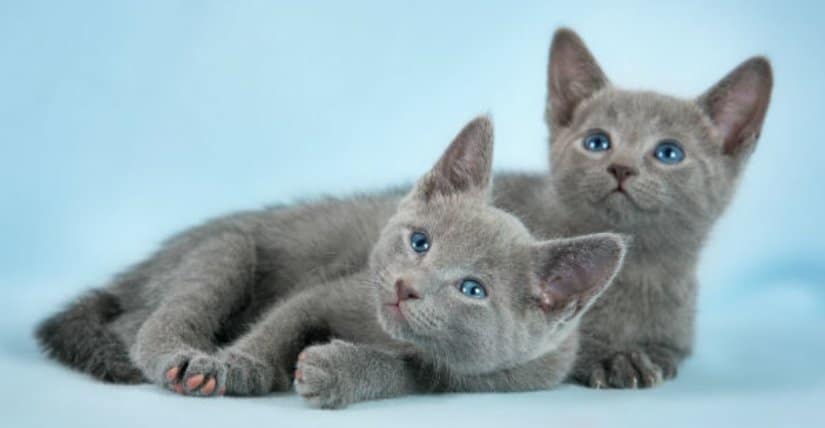
Socialization is very important for all cat breeds, no matter how docile a breed is. With socialization, cats learn how to get along with other cats, animals, and people. That said, your cat should never be placed in a dangerous environment or be near aggressive dogs or people.
All cat breeds that have not been socialized during kittenhood, and during the latter stages of life will fear humans and avoid human contact. By playing with and providing the best care for your rescue, you’ll be developing a close bond, and working toward reducing, and eventually eliminating any negative feline behaviors with positive clicker training.
Natural feline behaviors like urine marking, soiling outside the litter box, fighting with a new cat may be behaviors that you’ll have to deal with when bringing your new cat home. If you have other cats at home, they may be territorial, and see the newcomer as a threat. All these problems can be worked through with the help of a good veterinarian and cat behavioral therapist.
That said, the Russian Blue is one of the most popular cat breed around the world! With intelligent personalities, and fun attitudes, adopting a Russian Blue will be extremely rewarding. With so many cats up for adoption, it is the only way to go! There are so many cats in shelters today that desperately need a good home. When choosing your cat, ask questions, and look for a great temperament! That said, numerous cats can be quirky at shelters, but soon settle down in their new homes, and become very friendly and sociable.
In addition, kittens should be playful and curious. Sickly kittens that have bad odors or plenty of diarrhea stains, and a dull coat need to be seen by a veterinarian as soon as possible. Kittens when ill, can go downhill very quickly. However, the rewards of adopting a sick animal and caring for it are tremendous, provided that good veterinary care is provided right away.
Healthy kittens will also need plenty of care, numerous daily feedings, socialization, and positive litter box training. Keep in mind that vaccinations and parasite control are an important part of feline health care.
Consider pet health insurance for your Russian Blue. With so many great and affordable pet health plans available today, there’s no reason to avoid keeping your pet covered in case of an emergency.
Your cat will also need to be protected from household hazards, most especially electrical cables, poisonous plants, medication, and open windows. The Russian Blue makes for a wonderful adoption! As usual, make sure that children are always gentle and quiet around your cat.
Give your cat time to adjust to his new surroundings. As with any cat adoption, make sure that you have the time and resources to take good care of your very sweet and agile Russian Blue!
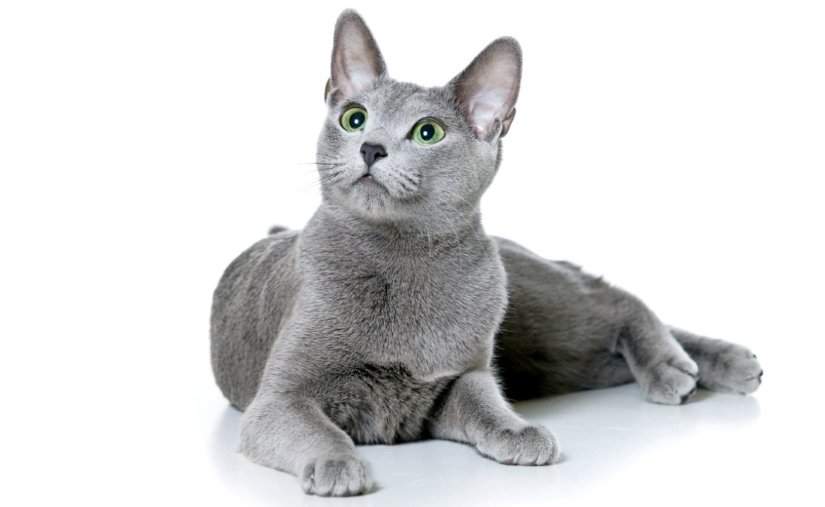
I would love to adopt a Russian blue cat💙